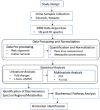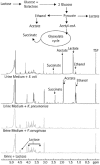Diagnostic Applications of Nuclear Magnetic Resonance-Based Urinary Metabolomics
- PMID: 28579794
- PMCID: PMC5428226
- DOI: 10.1177/1178623X17694346
Diagnostic Applications of Nuclear Magnetic Resonance-Based Urinary Metabolomics
Abstract
Metabolomics is a rapidly growing field with potential applications in various disciplines. In particular, metabolomics has received special attention in the discovery of biomarkers and diagnostics. This is largely due to the fact that metabolomics provides critical information related to the downstream products of many cellular and metabolic processes which could provide a snapshot of the health/disease status of a particular tissue or organ. Many of these cellular products eventually find their way to urine; hence, analysis of urine via metabolomics has the potential to yield useful diagnostic and prognostic information. Although there are a number of analytical platforms that can be used for this purpose, this review article will focus on nuclear magnetic resonance-based metabolomics. Furthermore, although there have been many studies addressing different diseases and metabolic disorders, the focus of this review article will be in the following specific applications: urinary tract infection, kidney transplant rejection, diabetes, some types of cancer, and inborn errors of metabolism. A number of methodological considerations that need to be taken into account for the development of a clinically useful optimal test are discussed briefly.
Keywords: Diagnosis; NMR spectroscopy; metabolomics; urine.
Conflict of interest statement
DECLARATION OF CONFLICTING INTERESTS: The author(s) declared no potential conflicts of interest with respect to the research, authorship, and/or publication of this article.
Figures





References
-
- Beckonert O, Keun H, Ebbels T, et al. Metabolic profiling, metabolomic and metabonomic procedures for NMR spectroscopy of urine, plasma, serum and tissue extracts. Nat Protoc. 2007;2:2692–2703. - PubMed
-
- Roessner U, Bowne J. What is metabolomics all about? Biotechniques. 46:363–365. - PubMed
-
- Van QN, Veenstra TD, Issaq HJ. Metabolic profiling for the detection of bladder cancer. Curr Urol Rep. 2011;12:34–40. - PubMed
-
- Duarte LF, Gil AM. Metabolic signatures of cancer unveiled by NMR spectroscopy of human biofluids. Prog Nucl Magn Reson Spectrosc. 2012;62:51–74. - PubMed
Publication types
LinkOut - more resources
Full Text Sources
Other Literature Sources

